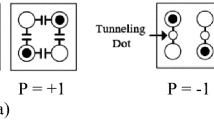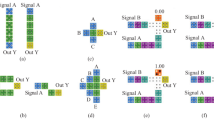Abstract
In this paper, different circuits of Quantum-dot Cellular Automata (QCA) are proposed for the so-called coplanar crossing. Coplanar crossing is one of the most interesting features of QCA because it allows for mono-layered interconnected circuits, whereas CMOS technology needs different levels of metalization. However, the characteristics of the coplanar crossing make it prone to malfunction due to thermal noise or defects. The proposed circuits exploit the majority voting properties of QCA to allow a robust crossing of wires on the Cartesian plane. This is accomplished using enlarged lines and voting. A Bayesian Network (BN) based simulator is utilized for evaluation; results are provided to assess robustness in the presence of cell defects and thermal effects. The BN simulator provides fast and reliable computation of the signal polarization versus normalized temperature. Simulation of the wire crossing circuits at different operating temperatures is provided with respect to defects and a quantitative metric for performance under temperature variations is proposed and assessed.
Similar content being viewed by others
References
S. Bhanja and S. Sarkar, “Graphical Probabilistic Inference for Ground State and Near-ground State Computing in Qca Circuits,” in IEEE Conference on Nanotechnology, July 2005.
S. Bhanja, M. Ottavi, F. Lombardi, and S. Pontarelli, “Novel Designs for Thermally Robust Coplanar Crossing in QCA,” IEEE Design and Testing in Europe Proc., vol. 1, no. 6, pp. 6–10, March 2006.
A. Fijany, N. Toomarian, and K. Modarress, Block QCA Fault-tolerant Logic Gates. Technical report, Jet Propulsion Laboratory, California, 2003.
A. Gin, P.D. Tougaw, and S. Williams, “An Alternative Geometry for Quantum-dot Cellular Automata,” J. Appl. Phys., vol. 85, no. 12, pp. 8281–8286, June 1999.
K. Hennessy and C. Lent, “Clocking of Molecular Quantum-dot Cellular Automata,” J. Vac. Sci. Technol., vol. 19, no. B, pp. 1752–1755, 2001.
C. Lent, “Molecular Quantum-dot Cellular Automata,” Seminar, May 2004.
C. Lent and P. Tougaw, “Lines of Interacting Quantum-dot Cells—A Binary Wire,” J. Appl. Physi., vol. 74, pp. 6227–6233, 1993.
C. Lent and P. Tougaw, “A Device Architecture for Computing with Quantum Dots,” Proc. I.E.E.E., vol. 85, no. 4, pp. 541–557, April 1997.
S.K. Lim, R. Ravichandran, and M. Niemier, “Partitioning and Placement for Buildable Qca Circuits,” J. Emerg. Technol. Comput. Syst., vol. 1, no. 1, pp. 50–72, 2005.
G. Mahler and V.A. Weberruss, Quantum Networks: Dynamics of Open Nanostructures, Berlin Heidelberg New York: Springer, 1998.
M. Momenzadeh, M. Ottavi, and F. Lombardi, Modeling Qca Defects at Molecular-level in Combinational Circuits. IEEE International Symposium on Defect and Fault Tolerance in VLSI Systems DFT 2005, pp. 208–216, 2005.
P.M. Niemier, M.T. Kontz, M.J. Kogge, “A Design of and Design Tools for a Novel Quantum Dot Based Microprocessor,” in Design Automation Conference, pp. 227–232, June 2000.
J. Pearl, Probabilistic Reasoning in Intelligent Systems: Network of Plausible Inference, San Mateo, CA: Morgan Kaufmann, 1998.
G. Toth, Correlation and Coherence in Quantum-dot Cellular Automata. Ph.D. thesis, University of Notre Dame, 2000.
P.D. Tougaw and C.S. Lent, “Logical Devices Implemented using Quantum Cellular Automata,” J. Appl. Physi., vol. 75, no. 3, pp. 1818–1825, Oct 1994.
P.D. Tougaw and C.S. Lent, “Dynamic Behavior of Quantum Cellular Automata,” J. Appl. Physi., vol. 80, no. 15, pp. 4722–4736, Oct 1996.
K. Walus, T. Dysart, G. Jullien, and R. Budiman, “QCADesigner: A Rapid Design and Simulation Tool for Quantum-Dot Cellular Automata,” IEEE Trans. Nanotechnol., vol. 3, no., 1, pp. 26–29, 2004.
Author information
Authors and Affiliations
Corresponding author
Additional information
Editor: M. Tehranipoor
Rights and permissions
About this article
Cite this article
Bhanja, S., Ottavi, M., Lombardi, F. et al. QCA Circuits for Robust Coplanar Crossing. J Electron Test 23, 193–210 (2007). https://doi.org/10.1007/s10836-006-0551-y
Received:
Revised:
Published:
Issue Date:
DOI: https://doi.org/10.1007/s10836-006-0551-y




